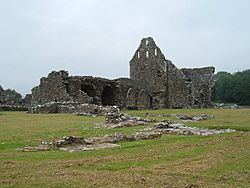Glenluce Abbey facts for kids
 |
|
| Monastery information | |
|---|---|
| Full name | Comune Monasterii Beate Maeri de Valle Lucis |
| Other names | Abbey of Luce |
| Order | Cistercian |
| Established | 1192 |
| Disestablished | 1602 |
| Mother house | Dundrennan Abbey |
| Diocese | Diocese of Galloway |
| Controlled churches | Glenluce |
| People | |
| Founder(s) | Lochlann, Lord of Galloway |
Glenluce Abbey is an old Cistercian monastery located near Glenluce, Scotland. It was also known as the Abbey of Luce or Vallis Lucis. A powerful leader named Lochlann, Lord of Galloway started the abbey around 1190.
After the Scottish Reformation in 1560, the abbey stopped being used. This was a big change in Scotland when many religious buildings were closed.
The Abbey's History
Glenluce Abbey was an important religious center for many years. Monks lived and worked there, following the rules of the Cistercian order. They spent their days in prayer and work.
Over time, the abbey's lands became controlled by powerful families. One such family was the Kennedy family.
Restoration of the Ruins
The ruins of Glenluce Abbey were fixed up and partly restored in 1898. An architect from Glasgow, Peter MacGregor Chalmers, led this work. Today, the abbey is a scheduled ancient monument. This means it is a special historical site protected by law.
Images for kids


